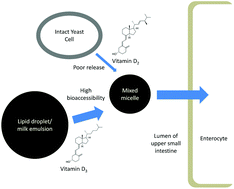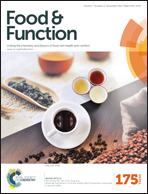Low bioaccessibility of vitamin D2 from yeast-fortified bread compared to crystalline D2 bread and D3 from fluid milks
Abstract
The assessment of the efficacy of dietary and supplemental vitamin D tends to be confounded by differences in the serum 25-hydroxyvitamin D response between vitamin D2 and vitamin D3. Serum response differences from these vitamers may be due to differences in bioavailability. To address this specifically, the bioaccessibility was assessed for vitamin D2 from breads fortified with UV-treated yeast, and a benchmark against staple vitamin D3 fortified foods including bovine milks and infant formula, as well as crystalline vitamin D2 fortified bread. Fortified foods were subjected to a three-stage static in vitro digestion model, and vitamin D was analyzed by HPLC-MS. Vitamin D bioaccessibility was significantly greater from bovine milks and infant formula (71–85%) than from yeast-fortified sandwich breads (6–7%). Bioaccessibility was not different between whole wheat and white wheat bread (p > 0.05), but was ∼4× lower from yeast-fortified bread than from crystalline vitamin D2 fortified bread (p < 0.05). Intact yeast cells were observed in the digesta of yeast fortified bread. These results indicate that the low bioavailability of yeast D2 in comparison to other vitamin D2 sources is likely due to entrapment within a less digestible yeast matrix and not only to metabolic differences between vitamins D2 and D3.


 Please wait while we load your content...
Please wait while we load your content...